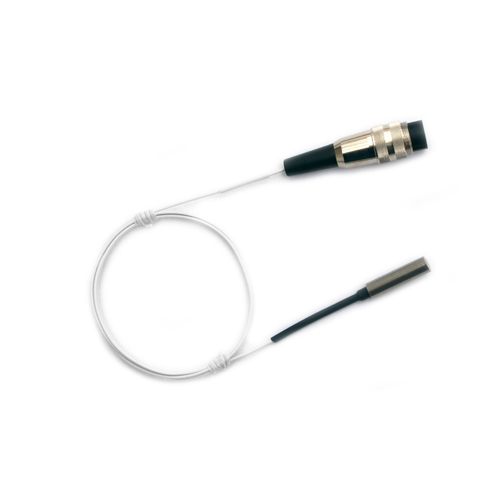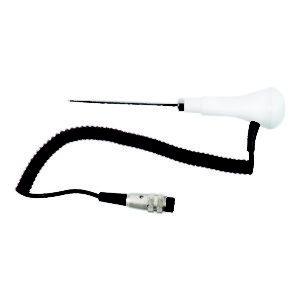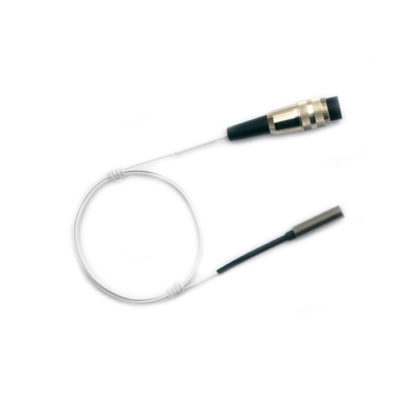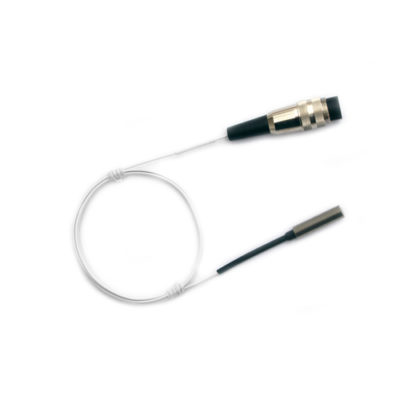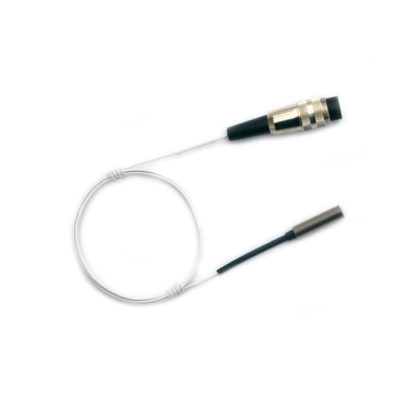PST Air Probe (5.0m Lead)
Part No: RFAX500 (3359458)The RFAX500 PST (Thermistor) Air Probe is a damped air probe for use with our wireless temperature monitoring systems. The probe is connected to a 5.0m lead.
- Temperature Range: -40°F to +158°F / -40 to +70°C
- Sensor Type: PST (Thermistor)
- Connector Type: Lumberg (6-Pin)
- Warranty: 6 Months
PST Air Probe (5.0m Lead)
The RFAX500 PST (Thermistor) Air Probe is a damped air probe for use with the Wireless Temperature Monitoring Systems. The probe is connected to a 5.0m lead.

The RFAX500 PST Air Probe is fitted with a 6-Pin Lumberg connector with locking screw, to provide a strong and secure probe-to-instrument connection with better prevention of liquid ingress.
Air Probes Explained
It is fair to say, that any probe that can measure temperature, could be used as an Air Probe, with varying degrees of success. However, Air Probes are specifically designed for this purpose and so have a higher degree of accuracy and response.
Air Probes are often designed to be very quick response with a low thermal mass. The sensor is designed to be as small as possible so that the air temperature is transferred to the probe with minimal temperature loss or gain to maintain a high degree of accuracy.
That said, all Comark Air Probes for Wireless Temperature Monitoring Systems are inherently designed to be slow. Why is this? Read on to find out….
We supply a Damped Air Probe style for our Wireless Monitoring Systems, which comes in the form of a small stainless steel bullet shaped end, see picture.

This type of construction has two purposes;
- It protects the sensor from physical damage
- It slows the response of the probe down significantly
In certain scenarios, it is beneficial to have a slower response to changes in air temperature, hence having a Damped Air Probe. For example, when you place a probe inside a fridge or freezer, you probably don’t want an alarm going off every time someone opens the door.
The Damped Air Probes do a good job of reflecting the samples in the fridge. As our Wireless Temperature Monitoring Systems are your early warning notification for any alarms, it would be unsuitable if ‘false alarms’ were constantly being raised.
All Wireless Temperature Monitoring System Air Probes are fitted with a 6-Pin Lumberg Connector and a stainless steel Damped Air Probe end, as shown below.
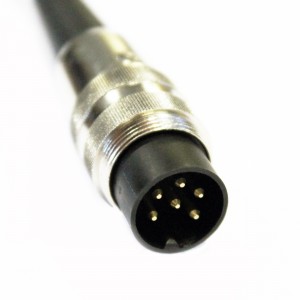
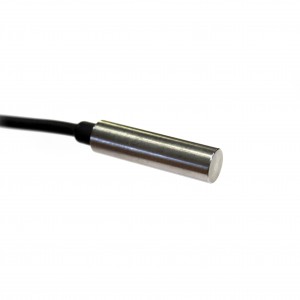
Technical Specifications
| Name | Value |
|---|---|
| Lead Length | 5.0m |
| Connector Type | Lumberg (6-Pin) |
| Sensor Type | PST (Thermistor) |
| Stem Length | 30mm |
| Stem Diameter | 8mm |
| Temperature Range | -40 to +70°C / -40°F to +158°F |
| Wire Type | Flat-Twin |
| Lead Material | PVA |
| Warranty | 6 Months |
Articles / FAQs
| Name | Date |
|---|---|
My Probe is stuck in the Lumberg connector?My Probe is stuck in the Lumberg connector?If you are using a Probe, connected to your device via a 6-Pin Lumberg connector and the Probe appears to be stuck in the connector, then it may have been over-tightened. You should initially try to release the screw thread connector gently. To prevent the connector from locking in the future, you could use food safe grease on the connector threads. This problem may also be prevented by keeping the instrument clean when in use. If this does not work, you will need to return your instrument for service.
| 20th April 2015 |
General Care of Temperature ProbesGeneral Care of Temperature ProbesThe Probe is where most of the action with any Thermometer takes place. Almost every operation requires a Probe reading. The Probe should be treated with care in order to ensure best functioning and long life. We would recommend that you always have a spare, properly functioning Probe on hand, just in case the primary Probe breaks, or appears to be reading incorrectly. You should not stretch the coiled cable of any Probe, to reach an item to be measured. We would recommend instead that you ALWAYS move BOTH the Probe and the Thermometer, toward the food to be measured. This will help avoid unnecessary stress on the wires inside the Probe. You should not touch the coiled cable or Probe handle to hot surfaces, that might melt the protective coatings, which in turn could damage the Probe wires and render the Probe inoperable. You should not bend the tip of any Penetration Probe, as this too could break the wires and render the Probe inoperable. In general, Penetration Probes are designed for penetrating thawed food only and not for testing frozen food or containers or chipping ice.
You should clean the Probe and wire coil with a clean damp cloth, being VERY careful not to pull or stretch the coil and damage the wires inside. |
Related products
- RFAX600
%27%20fill-opacity%3D%27.5%27%3E%3Cellipse%20fill%3D%22%23cdcdcd%22%20fill-opacity%3D%22.5%22%20rx%3D%221%22%20ry%3D%221%22%20transform%3D%22rotate(-179.4%20142.5%2079.7)%20scale(54.859%2093.4753)%22%2F%3E%3Cpath%20fill%3D%22%23dbdbdb%22%20fill-opacity%3D%22.5%22%20d%3D%22M208.6%2080.5h136v75h-136z%22%2F%3E%3Cpath%20fill%3D%22%23fff%22%20fill-opacity%3D%22.5%22%20d%3D%22M339.5%20424.2L238%20172.3-1.1-24.2l.8%20448.4z%22%2F%3E%3Cellipse%20fill%3D%22%23fff%22%20fill-opacity%3D%22.5%22%20rx%3D%221%22%20ry%3D%221%22%20transform%3D%22matrix(-17.31783%20-48.06578%20215.48983%20-77.63977%20182%2058.6)%22%2F%3E%3C%2Fg%3E%3C%2Fsvg%3E)
PST Air Probe (6.0m Lead)
- RFAX200
%27%20fill-opacity%3D%27.5%27%3E%3Cellipse%20fill%3D%22%23ccc%22%20fill-opacity%3D%22.5%22%20rx%3D%221%22%20ry%3D%221%22%20transform%3D%22rotate(-8.2%201237.2%20-1889.2)%20scale(56.87373%2089.62153)%22%2F%3E%3Cpath%20fill%3D%22%23dbdbdb%22%20fill-opacity%3D%22.5%22%20d%3D%22M318.7%2067.4l-144%2064.2%20130.8%2080.2%2045.4-110.2z%22%2F%3E%3Cpath%20fill%3D%22%23fff%22%20fill-opacity%3D%22.5%22%20d%3D%22M54-24.2l-78.2%20448.4%20292.2-211zm268.2%20199.7l26.5%20248.7%2075.5-34.5-29-414z%22%2F%3E%3C%2Fg%3E%3C%2Fsvg%3E)
PST Air Probe (2.0m Lead)
- RFAX1000
%27%20fill-opacity%3D%27.5%27%3E%3Cellipse%20fill%3D%22%23cecece%22%20fill-opacity%3D%22.5%22%20rx%3D%221%22%20ry%3D%221%22%20transform%3D%22matrix(-57.30838%201.22789%20-2.03994%20-95.20882%20278.9%20161.9)%22%2F%3E%3Cpath%20fill%3D%22%23dbdbdb%22%20fill-opacity%3D%22.5%22%20d%3D%22M207%2082h137.5v68.8H207z%22%2F%3E%3Cpath%20fill%3D%22%23fff%22%20fill-opacity%3D%22.5%22%20d%3D%22M.8%20169.5H257v231.3H.8z%22%2F%3E%3Cpath%20fill%3D%22%23fff%22%20fill-opacity%3D%22.5%22%20d%3D%22M17.3%20219.8l-53.1-92%20345-199.2%2053.2%2092z%22%2F%3E%3C%2Fg%3E%3C%2Fsvg%3E)
PST Air Probe (10.0m Lead)
- RFAX100
%22%20transform%3D%22translate(.8%20.8)%20scale(1.5625)%22%20fill-opacity%3D%22.5%22%3E%3Cellipse%20fill%3D%22%23cdcdcd%22%20rx%3D%221%22%20ry%3D%221%22%20transform%3D%22matrix(-37.12866%205.20076%20-7.83265%20-55.91799%20179.5%20101)%22%2F%3E%3Cpath%20fill%3D%22%23dadada%22%20d%3D%22M205%2038l-96%2052%20117-9z%22%2F%3E%3Cpath%20fill%3D%22%23fff%22%20d%3D%22M0%20110h164v146H0z%22%2F%3E%3Cellipse%20fill%3D%22%23fff%22%20cx%3D%22239%22%20cy%3D%22154%22%20rx%3D%2231%22%20ry%3D%22108%22%2F%3E%3C%2Fg%3E%3C%2Fsvg%3E)
PST Air Probe (1.0m Lead)

